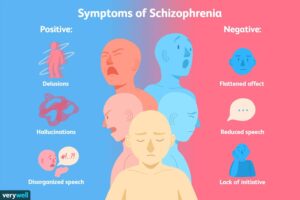Introduction to Psychosis
Psychosis is a perplexing mental health condition that affects millions of individuals worldwide. It is characterized by a profound disconnection from reality, often leading to hallucinations, delusions, and impaired cognitive function. This article delves into the intricacies of psychosis, offering insights into its causes, symptoms, and treatment options.
Unveiling the Nature of Psychosis
At its core, psychosis is a severe mental disorder that alters a person’s thoughts, perceptions, and behaviors. It is essential to grasp that psychosis isn’t a singular condition but rather a cluster of symptoms that can manifest in various psychiatric disorders. Schizophrenia, schizoaffective disorder, and bipolar disorder are a few examples where psychosis can rear its head.
Key Symptoms of Psychosis
Identifying the telltale signs of psychosis is crucial for early intervention and treatment. Common symptoms include:
- Hallucinations: These are sensory experiences that occur in the absence of external stimuli. For instance, individuals with psychosis might hear voices or see things that aren’t real.
- Delusions: Delusions are strongly held false beliefs that are resistant to reasoning or contrary evidence. They can manifest in various forms, such as paranoid delusions or grandiose delusions.
- Disorganized Thinking: People with psychosis often struggle with disorganized thoughts, making it difficult to communicate coherently or follow a logical train of thought.
- Impaired Functioning: Psychosis can severely impact daily life. Affected individuals may find it challenging to maintain relationships, employment, or perform routine tasks.
The Root Causes of Psychosis
While the precise causes of psychosis remain a subject of ongoing research, several factors are associated with its development:
- Genetics: There is evidence to suggest a genetic predisposition to psychosis. Individuals with a family history of mental illness may be at a higher risk.
- Brain Chemistry: Imbalances in neurotransmitters, like dopamine, play a role in the onset of psychosis. Medications that modulate these neurotransmitters are often used in treatment.
- Stress and Trauma: Traumatic experiences or chronic stress can trigger or exacerbate psychotic episodes in some individuals.
- Substance Abuse: The use of certain substances, such as drugs or alcohol, can induce psychosis, particularly in vulnerable individuals.
Diagnosis and Evaluation
Diagnosing psychosis is a complex process that requires a thorough evaluation by a mental health professional. This assessment may involve:
- Clinical Interviews: Gathering information about the individual’s symptoms, history, and family background.
- Psychological Testing: The use of standardized tests to assess cognitive function and detect the presence of lunacy.
- Physical Examinations: Eliminating any medical conditions that could be contributing to the symptoms.
Treatment Options
Psychosis is a treatable condition, and early intervention can significantly improve outcomes. Treatment strategies often include a combination of the following approaches:
- Medication: Antipsychotic drugs are a cornerstone of treatment for many individuals with insanity. They help to alleviate symptoms and improve overall functioning.
- Psychotherapy: Individual and group therapy sessions can assist individuals in managing their symptoms, understanding their condition, and improving social skills.
- Supportive Services: These services encompass vocational rehabilitation, housing support, and social skills training to help individuals with insanity integrate into their communities.
- Hospitalization: In severe cases, hospitalization may be necessary to ensure the safety of the individual and provide intensive treatment.
The Journey to Recovery
Recovering from insanity can be a challenging and ongoing process. It often involves finding the right combination of treatments and strategies that work for each individual. Additionally, a strong support system, including family, friends, and mental health professionals, plays a vital role in the recovery journey.
What are the 3 stages of psychosis?
The three stages of insanity are prodromal, acute, and recovery. The prodromal stage includes early, subtle symptoms. The acute stage involves intense symptoms like hallucinations and delusions. The recovery stage is about managing and improving symptoms.
What is psychosis behavior?
Lunacy behavior includes hallucinations, delusions, disorganized thinking, and impaired functioning. Hallucinations involve perceiving things that aren’t there, while delusions are strongly held false beliefs. Disorganized thinking affects communication, and impaired functioning hinders daily life.
What are the first symptoms of psychosis?
Early symptoms of insanity may include social withdrawal, decreased concentration, suspiciousness, and changes in sleep patterns. These symptoms often appear gradually, making early detection and intervention crucial.
Can psychosis be cured?
Insanity can be managed and treated, but a complete cure is less common. Early intervention, medications, psychotherapy, and support services can help individuals lead fulfilling lives and minimize symptoms.
What is the best treatment for psychosis?
The best treatment for mania often combines antipsychotic medications, psychotherapy, and supportive services. Medications can reduce symptoms, psychotherapy helps individuals manage their condition, and supportive services address practical aspects of daily life. The ideal treatment plan varies from person to person.
Read more:
Conclusion
In conclusion, lunacy is a complex mental health condition that affects individuals in a multitude of ways. It can be distressing not only for those who experience it but also for their loved ones. However, with the right diagnosis, treatment, and support, many individuals can manage their symptoms, regain their quality of life, and work toward recovery. If you or someone you know is struggling with symptoms of insanity, seeking help from a qualified mental health professional is the first step on the path to understanding, managing, and ultimately overcoming this enigmatic condition.

